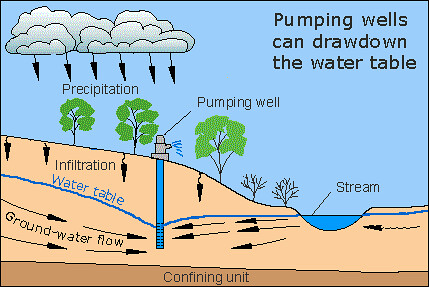The water cycle / drawdown and subsidence
Sustainability is the capacity to endure, says Wikipedia.
In ecology the word describes how biological systems remain diverse and productive over time. For humans it is the potential for long-term maintenance of well being, which in turn depends on the maintenance of the natural world and natural resources.[1]
Sustainability has become a wide-ranging term that can be applied to almost every facet of life on Earth, from local to a global scale and over various time periods.
Long-lived and healthy wetlands and forests are examples of sustainable biological systems.
Invisible chemical cycles redistribute water, oxygen, nitrogen and carbon through the world's living and non-living systems, and have sustained life since the beginning of time.
As the earth’s human population has increased, natural ecosystems have declined and changes in the balance of natural cycles has had a negative impact on both humans and other living systems.[2]
Paul Hawken has written that "Sustainability is about stabilizing the currently disruptive relationship between earth’s two most complex systems—human culture and the living world.”[3]
Ways of living more sustainably can take many forms from reorganising living conditions (e.g., ecovillages, eco-municipalities and sustainable cities), reappraising economic sectors (permaculture, green building, sustainable agriculture), or work practices (sustainable architecture), using science to develop new technologies (green technologies, renewable energy), to adjustments in individual lifestyles that conserve natural resources.
skip to main |
skip to sidebar
For students and parents who love education and exploration of the social sciences . . .
Search This Blog
Followers
Blog Archive
-
▼
2011
(242)
-
▼
September
(42)
- The Leo Fender and Red Hot Chili Peppers Quiz
- Sat, Oct 1, Water Haul: from Stoner Boat Launch to...
- Chicago, the Windy City, the capital of the Midwest
- El Pueblo de Nuestra Senora Reina de Los Angeles d...
- Talent Show meeting on Wed after school and Thurs ...
- Comparing Los Angeles and Chicago, Oct 3 - 4
- Mult-choice, open notes class notes quiz Wed-Th, 9...
- "Equal day and night:" the Equinox
- Geologists to visit 3 geography classes on Fri.
- Magnet geography: Los Angeles
- Indie work: comparison essays
- Healthy snack walking tour of Magnet campus on Wed
- Magnet geography / comparison essays & California map
- Larkin Edwards and Henry M Shreve: Two pioneers of...
- Guidelines for comparison essays in social studies
- Demographics: the study of populations
- The most populous state: California
- Inside Silicon Valley: the Google campus and many ...
- Spaceship Earth graphic project due Mon, 10 pts
- California map quiz next Wed
- California's tectonic vulnerability: the big one i...
- Sustainability: a key term for the coming generations
- Recommended: School directories are available to p...
- New guidelines for Friday night's Back-to-School D...
- Aquaculture is in your future
- Jump upon your Water cycle
- Noodling: the primitive art of hand fishing / a po...
- British adventurer David Cornthwaite goes the leng...
- Train gondolas that carry coal from Montana to Lou...
- No homework this week except have notes for brief ...
- Notes on 9/11 and Osama bin Laden
- Enriched-level geography: one book report per seme...
- The basics on NYC
- Magnet 9/11 Commemoration on Fri, Sept 9, 11:30 am
- Open notes quiz next class - about 15 questions
- Glaciers in the Himalayas are melting; effect will...
- Know the states through which Louisiana's coal sup...
- Culinary schools vs frustrated graduates: who's in...
- Get weekly news updates from Caddo Magnet HS in yo...
- Magnet vocab: 5 of the most important words
- Cmhs parent night begins at 5:30 pm on Thurs, Sept 8
- Caddo Magnet High bell schedule
-
▼
September
(42)

